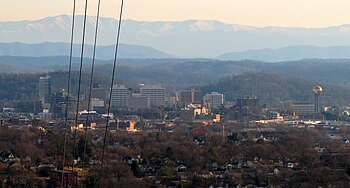Knoxville, Tennessee: Difference between revisions
Pat Palmer (talk | contribs) mNo edit summary |
Pat Palmer (talk | contribs) mNo edit summary |
||
| Line 3: | Line 3: | ||
'''Knoxville''' is the largest city in East [[Tennessee (U.S. state)|Tennessee]] and the county seat of Knox County. In 2020, its population was 190,740,<ref name=Population/> making it the state of Tennessee's third-most-populous city (after [[Nashville, Tennessee|Nashville]] and [[Memphis, Tennessee|Memphis]]).<ref name=2010census/> In 2020, the larger metropolitan area had 879,773 people.<ref name=MetroArea/> | '''Knoxville''' is the largest city in East [[Tennessee (U.S. state)|Tennessee]] and the county seat of Knox County. In 2020, its population was 190,740,<ref name=Population/> making it the state of Tennessee's third-most-populous city (after [[Nashville, Tennessee|Nashville]] and [[Memphis, Tennessee|Memphis]]).<ref name=2010census/> In 2020, the larger metropolitan area had 879,773 people.<ref name=MetroArea/> | ||
Knoxville surrounds the main campus of the [[University of Tennessee (Knoxville)|University of Tennessee]], whose basketball and football teams are enormously popular in the entire state. Knoxville is also home to the headquarters of the Tennessee Valley Authority, the Tennessee Supreme Court's courthouse for East Tennessee, and the corporate headquarters of several national and regional companies. The widely visited [[Great Smoky Mountains National Park]] is nearby. | |||
==Economic history== | |||
First settled in 1786, Knoxville was the state capital until 1843. The city struggled with geographic isolation throughout the early 19th century, until the arrival of the railroad in 1855 led to an economic boom.<ref name=wheeler/> During the [[American Civil War]], the city was bitterly divided over the issue of secession and was occupied alternately by the [[Confederate States of America|Confederate]] and U.S. (Union) armies, leading to the ''Battle of Fort Sanders'' in 1863.<ref name=wheeler/> After the 1860's, Knoxville became a major wholesaling and manufacturing center until the 1930's, when Knoxville's economy stagnated as the [[Great Depression, U.S.|manufacturing sector collapsed]] and the downtown area declined. City leaders became entrenched in highly partisan political fights.<ref name=wheeler/> Hosting the [[1982 World's Fair]] helped reinvigorate the city,<ref name=wheeler/> and revitalization initiatives by city leaders and private developers have had major successes in spurring growth especially the downtown area.<ref>"Ask Doc Knox", "[https://web.archive.org/web/20130725133226/http://blogs.metropulse.com/ask_dr_knox/2011/11/downtowns-homegrown-revival.html Downtown's Homegrown Revival]", ''Metro Pulse'', November 16, 2011. Accessed at the Internet Archive, October 1, 2015.</ref> | First settled in 1786, Knoxville was the state capital until 1843. The city struggled with geographic isolation throughout the early 19th century, until the arrival of the railroad in 1855 led to an economic boom.<ref name=wheeler/> During the [[American Civil War]], the city was bitterly divided over the issue of secession and was occupied alternately by the [[Confederate States of America|Confederate]] and U.S. (Union) armies, leading to the ''Battle of Fort Sanders'' in 1863.<ref name=wheeler/> After the 1860's, Knoxville became a major wholesaling and manufacturing center until the 1930's, when Knoxville's economy stagnated as the [[Great Depression, U.S.|manufacturing sector collapsed]] and the downtown area declined. City leaders became entrenched in highly partisan political fights.<ref name=wheeler/> Hosting the [[1982 World's Fair]] helped reinvigorate the city,<ref name=wheeler/> and revitalization initiatives by city leaders and private developers have had major successes in spurring growth especially the downtown area.<ref>"Ask Doc Knox", "[https://web.archive.org/web/20130725133226/http://blogs.metropulse.com/ask_dr_knox/2011/11/downtowns-homegrown-revival.html Downtown's Homegrown Revival]", ''Metro Pulse'', November 16, 2011. Accessed at the Internet Archive, October 1, 2015.</ref> | ||
==Attribution== | ==Attribution== | ||
Revision as of 08:42, 25 July 2024
Knoxville is the largest city in East Tennessee and the county seat of Knox County. In 2020, its population was 190,740,[1] making it the state of Tennessee's third-most-populous city (after Nashville and Memphis).[2] In 2020, the larger metropolitan area had 879,773 people.[3]
Knoxville surrounds the main campus of the University of Tennessee, whose basketball and football teams are enormously popular in the entire state. Knoxville is also home to the headquarters of the Tennessee Valley Authority, the Tennessee Supreme Court's courthouse for East Tennessee, and the corporate headquarters of several national and regional companies. The widely visited Great Smoky Mountains National Park is nearby.
Economic history
First settled in 1786, Knoxville was the state capital until 1843. The city struggled with geographic isolation throughout the early 19th century, until the arrival of the railroad in 1855 led to an economic boom.[4] During the American Civil War, the city was bitterly divided over the issue of secession and was occupied alternately by the Confederate and U.S. (Union) armies, leading to the Battle of Fort Sanders in 1863.[4] After the 1860's, Knoxville became a major wholesaling and manufacturing center until the 1930's, when Knoxville's economy stagnated as the manufacturing sector collapsed and the downtown area declined. City leaders became entrenched in highly partisan political fights.[4] Hosting the 1982 World's Fair helped reinvigorate the city,[4] and revitalization initiatives by city leaders and private developers have had major successes in spurring growth especially the downtown area.[5]
Attribution
- Some content on this page may previously have appeared on Wikipedia.
References
- ↑ U.S. Census Bureau QuickFacts: Knoxville city, Tennessee.
- ↑ U.S. Census Bureau, 2010 Census Interactive Population Search. Retrieved: December 20, 2011.
- ↑ 2020 Population and Housing State Data. United States Census Bureau, Population Division (August 12, 2021).
- ↑ 4.0 4.1 4.2 4.3 W. Bruce Wheeler, "Knoxville". The Tennessee Encyclopedia of History and Culture, 2002. Retrieved: February 28, 2008.
- ↑ "Ask Doc Knox", "Downtown's Homegrown Revival", Metro Pulse, November 16, 2011. Accessed at the Internet Archive, October 1, 2015.
